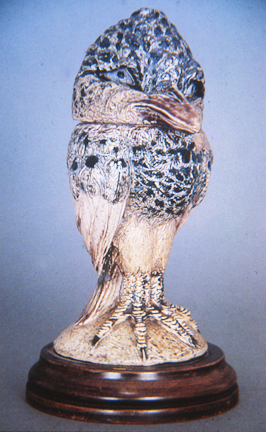The spirit of the Arts and Crafts Movement was that through the educated
creation of well made objects that the artist-craftsman could find beauty
and meaning in life. However, during this period, ceramic grotesques were
also popular. The eccentric work of the Martin brothers was inspired by
the publication of Lewis Carrol's Alice Through the Looking Glass,
with its Jabberwocky illustrations by John Tenniel. R. Wallace Martin sculpted
defiantly individual freestanding birds, often in pairs or groups, derived
from recognizable birds, such as owls (as in this example) or herons, with
human features, which were often caricatures of public figures of the day.
These figures came to be called 'Wally Birds,' after their creator, R.
Wallace Martin. The Martins were the first group to establish a working
method now common among studio ceramic artists in that they performed every
step in the process within their own studio space. They had been 'discovered'
at Lambeth Art college by Henry Doulton, who had them come to work for him
at his Studio Pottery line where they learned how to do salt glazing and
firing. When they established their own studio, they would continue to
use the salt glazing process. They were notorious paranoids, and many stories
are told of how they would have visitors to their studio thrown out by the
police, on charges that they were spies. In addition to the Wally Birds,
and other ceramic grotesques, they also produced a line of more functional
pottery, painted with relief decoration.

'Wally Bird' Tobacco Jar, by Wallace Martin
salt glazed stoneware, 9.5" ht. 1890


